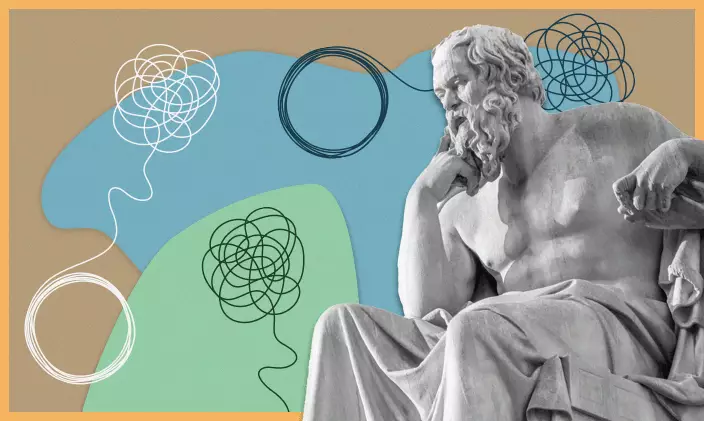5 educational learning theories and how to apply them
This article was updated on April 22, 2024.
╠²

Written by Michael Feder

Reviewed by Pamela M. Roggeman, EdD, Dean,╠²College of Education

Listen to article
What are learning theories in education?╠²╠²
Learning theories are conceptual frameworks that describe how people absorb, process and retain information.
Theories in education didnŌĆÖt begin in earnest until the early 20th century, but curiosity about how humans learn dates back to the ancient Greek philosophers Socrates, Plato and Aristotle. They explored whether knowledge and truth could be found within oneself () or through external observation ().
By the 19th century, psychologists began to answer this question with scientific studies. The goal was to understand objectively how people learn and then develop teaching approaches accordingly.
In the 20th century, the debate among educational theorists centered on behaviorist theory versus cognitive psychology. In other words, do people learn by responding to external stimuli or by using their brains to construct knowledge from external data?
Why are learning theories important in education?
Learning theories help teachers and others who work in education better understand how people acquire knowledge. The theories can help curriculum designers develop more effective educational materials, and they can help teachers apply those materials more successfully in the classroom. After all, when those in charge of learning have this information in hand, they can help their students learn more effectively.
That applies to more than classroom lessons too. Applying educational theories can help engage learners as they collaborate with one another, and it can promote lifelong learning as people understand how they best learn.
ThatŌĆÖs why educator preparation programs spend so much time having teacher candidates study human development and multiple learning theories. Foundational knowledge of how humans learn ŌĆö specifically how a child learns and develops cognitively ŌĆö is essential for educators who want to become effective instructors in the classroom.

Pamela Roggeman
EdD, Dean of SMĄ„Į╠╦∙ŌĆÖs College of Education
Pamela Roggeman, EdD, dean of SMĄ„Į╠╦∙ŌĆÖs╠²College of Education, explains her take on the role learning theory plays in preparing teachers: ŌĆ£Just as no two people are the same, no two students learn in the exact same way or at the same rate. Effective educators need to be able to pivot and craft instruction that meets the needs of the individual student to address the needs of the whole child.
ŌĆ£Sound knowledge of multiple learning theories is a first step toward this and another reason why great teachers work their entire careers to master both the╠²art and the science╠²of teaching.ŌĆØ
Although most teaching roles donŌĆÖt require adhering to a particular learning theory, educators likely already follow one or another theory, even if they arenŌĆÖt consciously aware of it. Following guide their students to success because they allow educators to offer alternative effective teaching strategies.
So, whether youŌĆÖre an aspiring or experienced teacher, a student or a student's parent or guardian, knowing more about each theory can make you more effective in fostering learning.
5 types of learning theories in education╠²
Educators typically familiarize themselves with five primary learning theories. Each prioritizes different concepts. These learning theories are:
- Behaviorism
- Cognitivism
- Constructivism
- Humanism
- Connectivism
Behaviorism
Behaviorism has roots in the work of John Watson, who is often regarded as the father of behavioral psychology.
Explanation: Behaviorism is concerned only with╠², as they can be studied in a systematic and observable manner.
Application: Learning is based on a system of routines that ŌĆ£drillŌĆØ information into a studentŌĆÖs memory bank and elicit positive feedback from teachers and the educational institution itself. (Students who do an excellent job receive positive reinforcement and are signaled out for recognition.)
Most teachers who use behaviorist principles focus on delivering prompt feedback to encourage student learning. They also implement reward systems that reinforce good behavior. Finally, many teachers establish consistency by starting their classes with routine activities, like problems on the board.
Cognitivism
Cognitive learning theory ŌĆö or cognitivism ŌĆö stems from the work of Jean Piaget (the founder of cognitive psychology) and focuses on the internal processes surrounding information and memory. It involves schema, the basic unit of knowledge, and schemata that build up over time.
Explanation: Learning relies on external factors (like information or data) and the internal thought process.
Application: Developed in the 1950s, this theory moves away from behaviorism to focus on the mindŌĆÖs role in learning.
Teachers who engage in cognitive learning might ask students about their experiences with the lesson and emphasize connections between past ideas and new ones. Incorporating student experiences, perspectives and knowledge can foster engagement with the material and help students feel respected.
Constructivism
Constructivism promotes active, internal learning processes that use new information to build upon a foundation of previously acquired knowledge.
Explanation: The learner builds upon their previous experience and understanding to ŌĆ£constructŌĆØ a new understanding.
Application: In constructivism, Roggeman says, students take an active approach to learning. Rather than being ŌĆ£filled upŌĆØ with knowledge, they construct meaning by interacting with the world around them, as with experiments or studies.
Some of the best ways teachers can use constructivism in the classroom include promoting student autonomy by encouraging students to be active in their learning. Hands-on experimentation with interactive materials can also empower them to learn better, especially in science classes, because it can promote engagement and connectiveness in student learning. Open-ended questions are another tool for constructivist learning, since they can help foster classroom conversation and dialogue, which encourages students to think critically and form questions and solutions in real time.
Humanism
emphasizes the importance of personal growth, self-actualization and whole-person development. Humanist learning theory emphasizes the unique needs and capabilities of each student and underscores the efficacy of a personalized education.
Explanation: This approach focuses on the unique capabilities of each learner rather than the method or materials.
Application: With the understanding that people are inherently good, humanism focuses on creating an environment conducive to self-actualization. In doing so, learnersŌĆÖ needs are met and learners themselves are then free to determine their own goals while the teacher assists them in meeting those learning goals.
In the classroom, a humanistic approach might look like a teacher providing students with choices about what to study in order to promote autonomy and intrinsic motivation. It also emphasizes positive teacher-student relationships, making it important for teachers to form connections with each student. Humanistic educators might use discussions, group work and self-evaluation to encourage critical thinking and this sort of connection.
Connectivism
is a newer learning theory. It posits that knowledge and learning reside in diverse sources and experiences. That includes understanding how to navigate and source further information via digital means.
Explanation: Informed by the digital age, connectivism departs from constructivism by identifying and remediating gaps in knowledge.
Application: Strongly influenced by technology, connectivism focuses on a learnerŌĆÖs ability to source and update accurate information frequently. Knowing how and where to find the best information is as important as the information itself.
In the classroom, students are likely to learn good digital literacy habits to help navigate online resources to answer their questions. They may also use digital tools to collaborate.
Other types of learning theories in education╠²
Like students themselves, learning theories in education are diverse. Although the five learning theories we have described are some of the most prominent, there are others to discover, such as:
- Transformative╠²learning theory: One of the most prominent adult learning theories, transformative learning theory posits that new information can essentially change our worldviews when our life experience and knowledge are paired with critical reflection.
- Social╠²learning theory: This theory incorporates some of the tacit tenets of peer pressure. Specifically, students observe other students and model their behavior accordingly. Sometimes itŌĆÖs to emulate peers; other times itŌĆÖs to distinguish themselves from peers. Harnessing the power of involves getting studentsŌĆÖ attention, focusing on how students can retain information, identifying when itŌĆÖs appropriate to reproduce a previous behavior, and determining studentsŌĆÖ motivation.
- Experiential╠²learning theory: There are plenty of clich├®s and parables about teaching someone something by doing it, although it wasnŌĆÖt until the early 1980s that it became an . This approach emphasizes learning about and experiencing something so that students can apply knowledge in real-world situations.
How educational theories influence learning╠²
Educational theories influence learning in a variety of ways. Learning theory examples can affect teachers' approach to instruction and classroom management. Finding the right approach (even if combining two or more learning theories) can make the difference between an effective and inspiring classroom experience and an ineffective one.
Applied learning theories directly influence a classroom experience in a variety of ways, such as:
- Providing students with╠²structure╠²and a comfortable, steady environment
- Helping educators, administrators, students and parents╠²align on goals and outcomes
- Empowering╠²teachers╠²to determine their educational approach based on the needs of their students
- Influencing╠²how╠²and what╠²a person learns
- Helping outsiders (colleges, testing organizations, etc.)╠²determine what kind of education╠²a student has had or is receiving
- Allowing students to have a voice in determining╠²how the class will be managed
- Deciding if╠²instruction will be primarily teacher-led or student-led
- Determining╠²how much collaboration╠²will happen in a classroom
How to apply learning theories in education╠²
So, how do learning theories apply in the real world? Education is an╠²evolving field with a complicated future. And according to Roggeman, the effects of applied educational theory can be long-lasting. ŌĆ£The learning theories we experienced as a student influence the type of work environment we prefer as adults,ŌĆØ she explains. ŌĆ£For example, if one experienced classrooms based heavily on social learning during the K-12 years, that person, as an adult, may be very comfortable in a highly collaborative work environment. Reflection on oneŌĆÖs educational history might serve as an insightful tool as to oneŌĆÖs own fulfillment in the workplace.ŌĆØ
Educational theories have come a long way since the days of Socrates and even the pioneers of behaviorism and cognitivism. While learning theories will no doubt continue to evolve, teachers and students alike can reap the benefits of this evolution as we continue to develop our understanding of how humans most effectively learn.
Expand your educational knowledge at SMĄ„Į╠╦∙╠²
SMĄ„Į╠╦∙ offers a variety of degree programs and certificates to help educators and aspiring educators optimize their classroom experience. Discover the following:
- Online bachelorŌĆÖs degrees in education: Students can lay the foundation for a career in early childhood education or elementary education with one of these two degree programs and prepare for teacher licensure.
- Online masterŌĆÖs degrees in education: Refine your career goals with an advanced degree in education. Options include focusing on adult education, curriculum and instruction, and special education, among others.
- Online Doctor of Education: Ready to solve complex problems in education? This terminal degree program takes a deep dive into how to improve performance using critical and innovative thinking.

ABOUT THE AUTHOR
A graduate of Johns Hopkins University and its Writing Seminars program and winner of the Stephen A. Dixon Literary Prize, Michael Feder brings an eye for detail and a passion for research to every article he writes. His academic and professional background includes experience in marketing, content development, script writing and SEO. Today, he works as a multimedia specialist at SMĄ„Į╠╦∙ where he covers a variety of topics ranging from healthcare to IT.

ABOUT THE REVIEWER
As dean of the SMĄ„Į╠╦∙ College of Education,╠²Pamela Roggeman has spent over a decade in higher education teacher preparation in both the public and private sector. Her experience has included national partnerships that help to advance thought leadership in the field of education. Dr. Roggeman also serves as the President of the Arizona Educational FoundationŌĆÖs Board of Directors.
This article has been vetted by SMĄ„Į╠╦∙'s editorial advisory committee.╠²
Read more about our editorial process.
╠²
want to read more like this?


